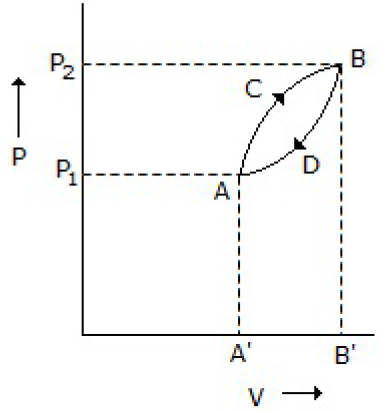Related Questions
Cp - Cv = R is valid for __________ gases.
Ideal
Very high pressure
Very low temperature
All of the above
A domestic refrigerator has a/an __________ cooled condenser.
Water
Air
Evaporative
Gas
The root mean square speed of molecules of a gas is equal to (where, m = mass of the molecule K = Boltzmanns constant, T = absolute temperature)
√(2KT/m)
√(3KT/m)
√(6KT/m)
3KT/m
At absolute zero temperature, the __________ of the gas is zero.
Pressure
Volume
Mass
None of these
The Joule-Thomson co-efficient is defined as (∂T/∂P)H. Its value at the inversion point is
∞
1
0
-ve
Measurement of thermodynamic property of temperature is facilitated by __________ law of thermodynamics.
1st
Zeroth
3rd
None of these
The partial molar enthalpy of a component in an ideal binary gas mixture of composition Z, at a temperature T and pressure P, is a function only of
T
T and P
T, P and Z
T and Z
Clausius-Clapeyron Equation gives accurate result, when the
Vapour pressure is relatively low and the temperature does not vary over wide limits
Vapour obeys the ideal gas law and the latent heat of vaporisation is constant
Volume in the liquid state is negligible compared with that in the vapour state
All (A), (B) and (C)
In any spontaneous process, the __________ free energy decreases.
Helmholtz
Gibbs
Both a & b
Neither 'a' nor 'b'
Change of heat content when one mole of compound is burnt in oxygen at constant pressure is called the
Calorific value
Heat of reaction
Heat of combustion
Heat of formation
A thermodynamic system is taken from state A to B along ACB and is brought back to A along BDA as shown below in the P-V diagram. The net work done during the complete cycle is given by the area covered by

P1ACBP2P1
ACBB1A1A
ACBDA
ADBB1A1A
An ideal gas is taken around the cycle ABCA as shown in P-V diagram below: The work done by the gas during the cycle is equal to

12 P1V1
6 P1 V1
3 P1V1
P1 V1
The temperature at which a real gas obeys the ideal gas laws over a wide range of pressure is called the __________ temperature.
Critical
Boyle
Inversion
Reduced
Maximum work that could be secured by expanding the gas over a given pressure range is the __________ work.
Isothermal
Adiabatic
Isentropic
None of these
Gibbs-Helmholtz equation is
ΔF = ΔH + T [∂(ΔF)/∂T]P
ΔF = ΔH - TΔT
d(E - TS) T, V < 0
dP/dT = ΔHvap/T.ΔVvap
Cv is given by
(∂E/∂T)V
(∂E/∂V)T
(∂E/∂P)V
(∂V/∂T)P
The reaction A (l) → R(g) is allowed to reach equilibrium conditions in an autoclave. At equilibrium, there are two phases, one a pure liquid phase of A and the other a vapor phase of A, R and S. Initially A alone is present. The numbers of degrees of freedom are:
1
2
3
0
Entropy of a substance remains constant during a/an __________ change.
Reversible isothermal
Irreversible isothermal
Reversible adiabatic
None of these
The equation, (d loge PA/d loge xA) = (d loge PA/d loge xB) applicable to a binary solution of components. A and B in equilibrium with their vapors at constant temperature and pressure is called the __________ equation.
Van Laar
Margules
Gibbs-Duhem
Gibbs-Duhem-Margules
Compressibility factor (i.e., the ratio of actual volume of gas to the volume predicted by ideal gas law) for all gases are
Always greater than one
Same at the same reduced temperature
Same at the same reduced pressure
Both (B) & (C)
__________ does not change during phase transformation processes like sublimation, melting & vaporisation.
Entropy
Gibbs free energy
Internal energy
All (A), (B) & (C)
While dissolving a gas into a liquid at a constant temperature, the ratio of the concentration of the gas in the solution phase and in the gaseous phase is
Infinity
Unity
Constant
Negative
For a real gas, the chemical potential is given by
RT d ln P
RT d ln f
R d ln f
None of these
For organic compounds, group contribution method can be used for the estimation of
Critical properties
Specific gravity
Specific volume
Thermal conductivity
Which of the following is Virial equation of state?
(p + a/V2)(V - b) = nRT
PV = nRT
PV = A + B/V + C/V2 + D/V3 + ...
None of these
Rotary lime kiln is an example of a/an __________ system.
Closed
Open
Isolated
Non-thermodynamic
First law of thermodynamics deals with the
Direction of energy transfer
Reversible processes only
Irreversible processes only
None of these
The first law of thermodynamics is a statement of conservation of
Heat
Momentum
Energy
Work
Lowering of condenser temperature (keeping the evaporator temperature constant) in case of vapour compression refrigeration system results in
Increased COP
Same COP
Decreased COP
Increased or decreased COP; depending upon the type of refrigerant
A system undergoes a change from a given initial state to a given final state either by an irreversible process or by a reversible process, then (where, Δ S1 and Δ SR are the entropy changes of the system for the irreversible and reversible processes respectively)
Δ S1 is always < Δ SR
Δ S1 is sometimes > Δ SR
Δ S1 is always > Δ SR
Δ S1 is always = Δ SR
